
St John, Bilsdale
The Church
This church was originally consecrated by the Archbishop of York, William Maclagan, on the 12th October 1896; some two and a half years after the foundation stone had been laid by the patron of Helmsley parish, the Earl of Feversham. It was the Earl who had in fact been the real moving spirit behind getting it built.
It was designed by the well known architect Temple Moor.
The story goes that when the builders met each morning they used to say, "We'll toss a coin. An if it stays up in t'air, we'll wark. Bud if it cum dahn, we'll gan ti t'Sun Inn for a beer".
Yet somehow the job was done. And in 1898 the new church was given its own new parish: Bilsdale Midcable. "Midcable" is a contraction of "middle chapel", the church being in the middle of the dale.
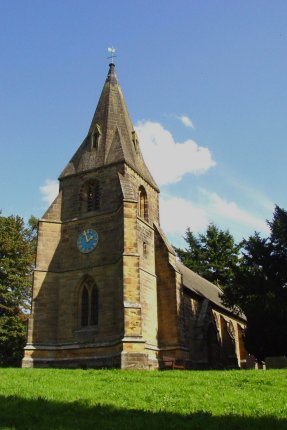
St John's Church
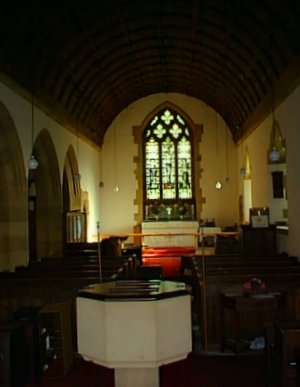
Inside St John's
The Work of the Monks
Before the coming of the monks in the mid-12th century, this whole area was - in the words of the chronicler William of Newburgh – "a vast and horrid wilderness". There was a little Scandinavian settlement up at Chop Gate, on a track running east-west, but otherwise Bilsdale was scarcely populated. And the lower-lying land was just an impenetrable swampy forest, through which wolves roamed.
But then the dale was shared out: most being donated, by the local lords, to Rievaulx Abbey; the north-eastern stretch to Kirkham Priory. (There were numerous boundary disputes, down the years). And the monks tamed it.
Rievaulx Abbey was founded in 1131. It was part of the rapidly growing new Cistercian Order, the white-robed monks. (The first Cistercian abbey had been founded in France in 1098.) And their great innovation was that they did not employ serfs, but instead for the first time allowed illiterate men actually to join the community, as "lay brothers".
Whilst the "choir monks" dedicated themselves to an intensive life of prayer at the main abbey, the lay brothers lived in outlying settlements called "granges" , frequently visiting the abbey to attend mass on Sundays and other feast days, but otherwise engaged in farm labour.
During the period when the great St. Aelred was abbot (1147-67) Rievaulx grew until there were some 140 choir monks and 500 lay brothers. Bilsdale had several granges: each with its own little oratory amongst the farm buildings, where the brothers would gather for prayer at the beginning and end of the day. They laboured mostly in silence, breaking off for brief prayers at the various canonical hours. They cut down the forest, drained the swamps and established great sheep runs. Between Laskill and Fangdale Beck they also opened a major quarry, for the abbey buildings. And there they also mined, and worked, iron ore.
Alas, the glory days for the Cistercian Order, generally, were fairly brief; and in the later Middle Ages Rievaulx dwindled away into a mere shadow of its former self. But for a little while at least - in the second half of the 12th century - it had been one of the great spiritual centres of Christendom, with Bilsdale as its chief hinterland.
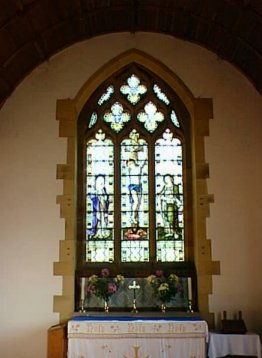
The east end
Twentieth Century Developments
By contrast, the Bilsdale of the 1890s, when St. John's was built, seems to have been a sleepy place of ancient rural custom - almost completely cut off from the surrounding world.
There was at that time still no proper road through the dale. In fact, the present road was not built until the beginning of the 1930s: this was the decisive moment when 20th century "progress" finally arrived.
And it was also in the 1930s that Fangdale Beck received its distinctive green telephone kiosk (just across the road), specially painted that colour at the request of Lord Feversham, to blend in with the landscape. Quite recently, in 1992, a great battle was fought over this, when - without any consultation - British Telecom removed it, to replace it with a conventional new "shower cubicle" box. Evidently they did not realize that what they had removed was a Grade II listed building! They were fined £3,000 and, to local delight, then ordered to restore the original.
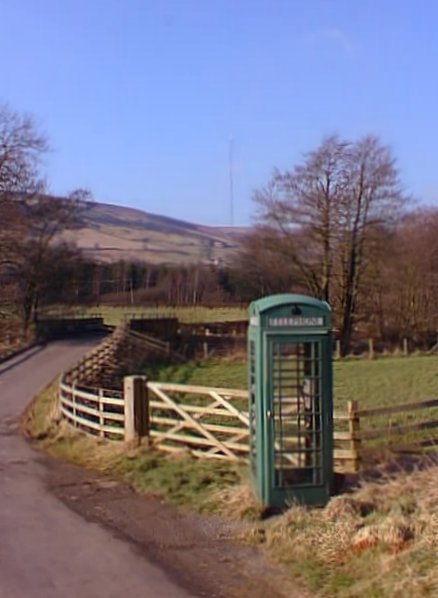
The green telephone kiosk with Bilsdale TV transmitter mast in the background
Upper Ryedale Parish
St. John's is a much loved church. Yet, to be honest - if one were simply concerned with crude practicalities - one might well wonder about the original wisdom of building it. For even in the 1890s there was scarcely the population to support it. And numbers have shrunk since then. Eventually, in 1974, things came to a head, and a decision was made to leave the post of vicar vacant for 5 years, with a view to possible closure.
However, it did not happen. And in recent years we have actually experienced a bit of a revival.
In 1979 Bilsdale Midcable was incorporated into the newly created parish of Upper Ryedale, along with Hawnby, Old Byland, Scawton and Cold Kirby. Although covering a great area, this is still, in terms of population, a very small parish indeed. But we continue to hold regular services here, at least once a month - cheerfully singing our hymns to the electronic accompaniment of Lincoln Cathedral Choir.
Visitors are always most welcome to join us.
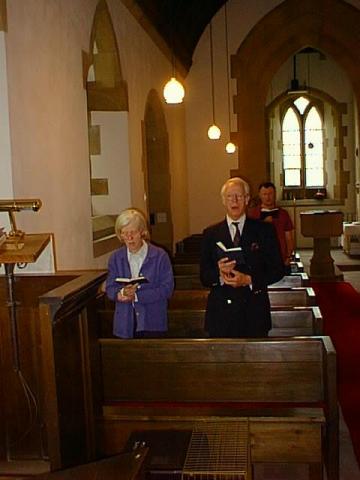
Sunday morning worship in St John's
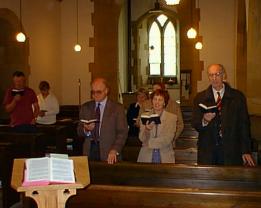
Home Page The Five Churches The Poetry Church Service Times About the Parish
Who's Who Tracing Your Ancestors Local History Hawnby Dreamers Useful Links